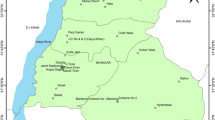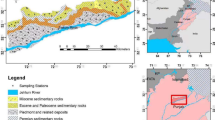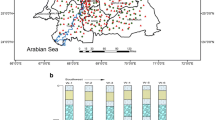Abstract
Elevated levels of arsenic in groundwater have caused serious health problems in many countries of the world. In the present study, the level of arsenic and associated physicochemical parameters of groundwater of Sahibganj district along the river Ganga in Jharkhand, India was assessed in three seasons. The groundwater was found to be Ca–HCO3 − type with low redox potential and high total dissolved solids load. Arsenic concentration was found to be highest in postmonsoon ranging between 1 and 133 µg L−1 compared to (2 to 98 µg L−1) monsoon and (7 to 115 µg L−1) premonsoon. Depth-wise heterogeneity suggested an incremental trend of arsenic with depth. Arsenic was found to be positively correlated to depth, PO4 3− and Fe suggesting both natural and anthropogenic role in release mechanism. Principal Component Analysis helped further to support this observation. Spatial distribution of As indicated discrete patches with high concentrations. Health risk analysis revealed high to very high carcinogenic and non-carcinogenic risk for adults and children in the communities dependent on groundwater of the study area. The present observation will help in defining strategies for managing the arsenic problems of Sahibganj in future.






Similar content being viewed by others
References
Álvarez E, Fernández Marcos ML, Vaamonde C, Fernández-Sanjurjo MJ (2003) Heavy metals in the dump of an abandoned mine in Galicia (NW Spain) and in the spontaneously occurring vegetation. Sci Total Environ 313:185–197. doi:10.1016/S0048-9697(03)00261-4
APHA (1998) Standard methods for the examination of water and waste water, vol 20. American Public Health Association, Washington, DC, pp 413–426
Bhattacharya P, Chatterjee D, Jacks G (1997) Occurrence of arsenic contaminated groundwater in alluvial aquifers from the delta plains, eastern India: option for safe drinking water supply. Int J Water Resour Dev 13:79–92
Bhattacharya P, Samal AC, Majumdar J, Santra SC (2009) Accumulation of arsenic and its distribution in rice plant (Oryza sativa L.) in GangeticWest Bengal, India. PaddyWater Environ. doi:10.1007/s10333-009-0180-z
Bortey-Sam N, Nakayama SMM, Ikenaka Y, Akoto O, Yohannes YB, Baidoo E, Mizukawa H, Ishizuka M (2015) Human health risks from metals and metalloid viaconsumption of food animals near gold mines in Tarkwa, Ghana: estimation of the daily intakes and target hazardquotients (THQs). Ecotoxicol Environ Saf 111:160–167
Bureau of Indian Standards (2009) Drinking water–specification (Second Revision of IS 10500)
Central Ground Water Board (2008) “Ground water information booklet” Sahebganj district, Jharkhand state. Ministry of Water Resources (Govt. of India). Mid–Eastern Region, Patna
Chakraborti D, Basu GK, Biswas BK, Chowdhury UK, Rahman MM, Chowdhury TR, Chanda CR, lodh D, Ray SL (2001) Characterisation of arsenicbearing sediments in Gangetic Delta of West Bengal, India. In: Chappell WR, Abernathy CO, Calderon RL (eds) Arsenic exposure and health effects. Elsevier, New York, pp 27–52
Chakraborti D, Sengupta MK, Rahman MM, Ahamed S, Chowdhury UK, Hossain A, Mukherjee SC, Pati S, Saha KC, Dutta RN (2004) Groundwater arsenic contamination and its health effects in the Ganga–Meghna–Brahmaputra Plain. J Environ Monit 6(6):74N–83N
Chakraborty S, Alam MO, Bhattacharya T, Singh YN (2014) Arsenic accumulation in food crops: a potential threat in Bengal Delta Plain. Water Qual, Expos Health 6:233–246
Chauhan D, Nickson R, Iyengar L, Sankararamakrishnan N (2009) Groundwater geochemistry and mechanism of mobilization of arsenic into the groundwater of Ballia district, UP. India Chemos 75(1):83–89
Chowdhury TR, Basu GK, Mandal BK, Biswas BK, Samanta G (1999) Arsenic poisoning in the Ganges delta. Nature 401:545–546
DPHE (Department of Public Health Engineering) (1999) Groundwater studies for arsenic contamination in Bangladesh. Main report and volumes S1–S5, report on Phase I. Dhaka, Bangladesh
ECETOC (European Centre for Ecotoxicology of Chemicals) (2001) Aquatic toxicity of mixtures. Technical report, 80. Brussels
ENHIS (European Environment and Health Information System) (2007) Exposure of children to chemical hazards in food. Fact Sheet No. 4.4, CODE: RPG4_Food_EX1. World Health Organization
Halder D, Bhowmick S, Biswas A, Chatterjee D, Nriagu J, Guha Mazumder D et al (2012) Risk of arsenic exposure from drinking water and dietary components: implications for risk management in rural Bengal. Environ Sci Technol. doi:10.1021/es303522s
Hossain AM, Akai J, Sakugawa H (2004) Mobilization of arsenic from subsurface sediments by effect of bicarbonate ions in groundwater. Chemosphere 54(6):753–762
Hossain MA, Rahman MM, Murrill M, Das B, Roy B, Dey S, Maity D, Chakraborti D (2013) Water consumption patterns and factors contributing to water consumption in arsenic affected population of rural West Bengal, India. Sci Total Environ 463–464:1217–1224
Huq SMI, Ara QAJ, Islam K, Zaher A, Naidu R (2001) The possible contamination from arsenic through food chain. In: Groundwater Arsenic Contamination in the Bengal Delta Plain of Bangladesh. In: Proceedings of the KTH-Dhaka University Seminar, University of Dhaka, Bangladesh. Jacks G, Bhattacharya P, Khan A.A (Eds.). KTH Special Publication, TRITA-AMI Report 3084, ISSN 1400-1306, ISRN KTH/AMI/REPORT 3084-SE, ISBN: 91-7283-076-X, © 2001, KTH, pp 91–96
Jeong CH (2001) Effect of land use and urbanization on hydrochemistry and contamination of groundwater from Taejon area, Korea. J Hydrol 253:194–210
Jiang Y, Huaming G, Yongfeng J, Yongsheng C, Chao H (2015) Principal component analysis and hierarchical cluster analyses ofarsenic groundwater geochemistry in the Hetao basin, Inner Mongolia. Chemie der Erde, Geochem 75:197–205
Kar S, Maity JP, Jean J-S, Liu C-C, Nath B, Yang H-J, Bundshuh J (2010) Arsenic-enriched aquifers: occurrences and mobilization of arsenic in groundwater of Ganges Delta Plain, Barasat, West Bengal, India. Appl Geochem 25:1805–1814
Katsoyiannis IA, Katsoyiannis AA (2006) Arsenic and other metal contamination of groundwaters in the industrial area of Thessaloniki, Northern Greece. Environ Monit Assess 123:393–406
Kinniburgh DG, Smedley PL (eds) (2001) Arsenic contamination of groundwater in Bangladesh, vol 4. British Geological Survey, Keyworth
Kumar P (2008) Targeting safe aquifers for Drinking water with special reference to arsenic contamination in Bhagalpur (Bihar) and Ghazipur (Uttar Pradesh) India. M. Phil thesis, Jawaharlal Nehru University, New Delhi
Kumar M, Kumar P, Ramanathan AL, Bhattacharya P, Thunvik R, Singh UK, Tsujimura M, Sracek O (2010) Arsenic enrichment in groundwater in the middle Gangetic plain of Ghazipur district in Uttar Pradesh, India. J Geochem Explor 105:83–94
Laluraj CM, Gopinath G (2006) Assessment on seasonal variation of groundwater quality of phreatic aquifers–a river basin system. Environ Monit Assess 117:45–57
Loring DH, Rantala RTT (1992) Manual for the geochemical analyses of marine sediments and suspended particulate matter. Earth-Science Reviews, 32: 2350283, and 1995, Regional Seas, Reference methods for marine pollution studies no. 63, United Nations Environment Programme
Mazumder DNG (2008) Chronic arsenic toxicity and human health. Indian J Med Res 128(4):436–447
McArthur JM, Banerjee DM, Hudson-Edwards KA, Mishra R, PurohitR Ravenscroft P et al (2004) Natural organic matter in sedimentary basins and its relation to arsenic in anoxic groundwater: the example of West Bengal and its worldwide implications. Appl Geochem 19:1255–1293
Mukherjee Rana JI, Kumar Nirmal, Manishita Das, Kumar RN (2011) Assessment of hydrochemical characteristics of a tropical wetland system using principal component analysis: a case study. The IUP J Environ Sci 5(1):37–50
Nath B, Stüben D, Basu Mallik S, Chatterjee D, Charlet L (2008) Mobility of arsenic in West Bengal aquifers conducting low and high groundwater arsenic. Part I: comparative hydro chemical and hydro geological characteristics. Appl Geochem 23:977–995
Nayak B, Das B, Mukherjee SC, Pal A, Ahamed S, Hossain MA, Maity P, Dutta RN, Dutta S, Chakraborti D (2008) Groundwater arsenic contamination in Sahibgunj district of Jharkhand state, India in middle Ganga plain and adverse health effects. Toxicol Environ Chem 90(4):673–694
Nickson R, McArthur J, Burgess W, Ahmed KM, Ravenscroft P, Rahman M (1998) Arsenic poisoning of Bangladesh groundwater. Nature 395:338
Nickson R, Sengupta C, Mitra P, Dave SN, Banerjee AK, Bhattacharya A, Basu S, Kakoti N, Moorthy NS, Wasuja M, Kumar M, Mishra DS, Ghosh A, Vaish DP, Srivastava AK, Tripathi RM, Singh SN, Prasad R, Bhattacharya S, Deverill P (2007) Current knowledge on the distribution of arsenic in groundwater in five states of India. J Environ Sci Health A Toxic Hazard Subst Environ Eng 42:1707–1718
Oinam JD, Ramanathan AL, Linda A, Singh G (2011) A study of arsenic, iron and other dissolved ion variations in the groundwater of Bishnupur District, Manipur. India Environ Earth Sci 62:1183–1195
Polizzotto ML, Kocar BD, Benner SG, Sampson M, Fendorf S (2008) Near-surface wetland sediments as a source of arsenic release to ground water in Asia. Nature 454:505–508
Rahman M, Vahter M, Wahed MA, Sohel N, Yunus M, Streatfield PK et al (2006) Prevalence of arsenic exposure and skin lesions. A population based survey in Matlab, Bangladesh. J Epidemiol Community Health 60(3):242–248
Ranjan RK, Ramanathan AL, Parthasarthy P, Kumar A (2013) Hydrochemical characteristics of groundwater in the plains of Phalgu river in Gaya, Bihar, India. Arab J Geosci 6:3257–3267
Ravenscroft P, Burgess WG, Ahmed KM, Burren M, Perrin J (2005) Arsenic in groundwater of the Bengal Basin, Bangladesh: distribution, field relations, and hydrogeological setting. Hydrogeol J 13(5–6):727–751
Ravindra K, Garg VK (2007) Hydro-chemical survey of groundwater of Hisar City and assessment of defluoridation methods used in India. Environ Monit Assess 132:33–43
Sappa G, Ergul S, Ferranti F (2014) Geochemical modeling and multivariate statistical evaluation of trace elements in arsenic contaminated groundwater systems of Viterbo Area, (Central Italy). SpringerPlus 3:237
Shome S, Roy P, Pal M, Bhati M (2014) Variation of adult and weight in India: state and zone wise analysis. Human Biol Review 3(3):242–257
Sikdar PK, Chakraborty S (2008) Genesis of arsenic in groundwater of North Bengal Plain using PCA: a case study of English Bazar Block, Malda District, West Bengal. India Hydrol Process 22:1796–1809
Stollenwerk KG, Briet GN, Welch AH, Yount JC, Whitney JW, Foster AL, Uddin M, Nehal M, Ratan K, Ahmed N (2007) Arsenic attenuation by oxidized aquifer sediments in Bangladesh. Sci Total Environ 379(2–3):133–150
USEPA (US Environmental Protection Agency) (1992) Definitions and general principles for exposure assessment. Guidelines for exposure assessment. Office of Pesticide Programs, Washington, D.C.
USEPA (US Environmental Protection Agency) (1997) Exposure factors handbook (EPA/600/P-95/002Fa) (update to Exposure factors handbook (EPA/600/8–89/043). Environmental Protection Agency Region I, Washington, D.C.
USEPA (US Environmental Protection Agency) (1999) A risk assessment–multiway exposure spreadsheet calculation tool. United States Environmental Protection Agency, Washington, D.C.
USEPA (US Environmental Protection Agency) (2001) Baseline human health risk assessment, Vasquez Boulevard and I–70 superfund site, Denver CO. http://www.epa.gov/region8/superfund/sites/VB-170-Risk.pdf
USEPA (US Environmental Protection Agency) (2009) National primary/secondary and drinking water regulations. Washington, D.C
van Geen A, Ahmed KM, Seddique AA, Shamsudduha M (2003) Community wells to mitigate the current arsenic crisis in Bangladesh. Bull World Health Org 82:632–638
WHO (2004) Guideline for drinking-water quality, 3rd edn (Recommendations). World Health Organization, Geneva
WHO (2007) Joint FAO/WHO Expert Standards Program Codex Alimentation Commission, Geneva. http://www.who.int
Acknowledgments
The authors would like to acknowledge the Department of Science and Technology, New Delhi for funding the SERB Young Scientist project SR/FTP/ES-2/2013 entitled “Arsenic enrichment in agricultural soils with potential impacts on crops and food security of Sahibganj, Jharkhand, India” for undertaking this study.
Author information
Authors and Affiliations
Corresponding author
Rights and permissions
About this article
Cite this article
Alam, M.O., Shaikh, W.A., Chakraborty, S. et al. Groundwater Arsenic Contamination and Potential Health Risk Assessment of Gangetic Plains of Jharkhand, India. Expo Health 8, 125–142 (2016). https://doi.org/10.1007/s12403-015-0188-0
Received:
Revised:
Accepted:
Published:
Issue Date:
DOI: https://doi.org/10.1007/s12403-015-0188-0




